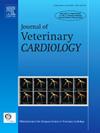Ventricular tachycardia as the main manifestation of primary cardiac lymphoma in a dog
IF 1.3
2区 农林科学
Q2 VETERINARY SCIENCES
引用次数: 0
Abstract
An 11-year-old cocker spaniel was referred with a one-day history of lethargy. Upon presentation, cardiac auscultation revealed a tachyarrhythmia. Two-dimensional transthoracic echocardiography with concurrent electrocardiographic tracing showed biventricular systolic dysfunction, mild left atrial dilation, functional mitral and tricuspid regurgitations, and sustained wide-complex monomorphic tachycardia (heart rate: 330 beats per minute), primarily consistent with ventricular tachycardia. Laboratory test results were unremarkable, except for an elevated serum concentration of cardiac troponin I (2.84 ng/mL). Initially, despite the intravenous administration of lidocaine and esmolol, cardioversion was not achieved. Oral amiodarone was subsequently added to the antiarrhythmic protocol, resulting in the restoration of sinus rhythm, followed by an improvement in the dog's clinical condition and biventricular systolic function on repeated echocardiographic examination. Accordingly, the dog was discharged from the hospital on amiodarone therapy. However, four days later, the dog returned with a relapse of symptomatic ventricular tachycardia. Despite prompt management, the dog succumbed to the progression of ventricular tachycardia into ventricular fibrillation. Interestingly, although repeated echocardiographic examinations did not reveal abnormalities suggesting a cardiac tumor, macroscopic and histological findings led to the diagnosis of primary cardiac lymphoma of T-cell origin. This case contributes to the currently limited scientific literature on primary cardiac lymphoma in dogs. Moreover, it contributes to raising awareness among veterinary cardiologists about the potential limitations of two-dimensional transthoracic echocardiography in detecting cardiac lymphoma in dogs, as well as the possible arrhythmogenic role of this rare condition in the species.
犬原发性心脏淋巴瘤的主要表现为室性心动过速
一只11岁的可卡犬有一天嗜睡的病史。经心脏听诊发现心律失常。经胸二维超声心动图并发心电图示双室收缩功能不全,左心房轻度扩张,二尖瓣和三尖瓣功能性反流,持续宽复单型心动过速(心率:330次/分钟),与室性心动过速基本一致。除了心肌肌钙蛋白I血清浓度升高(2.84 ng/mL)外,实验室检查结果无显著差异。最初,尽管静脉给予利多卡因和艾司洛尔,但没有实现心律转复。随后在抗心律失常方案中加入口服胺碘酮,导致窦性心律恢复,随后狗的临床状况和双心室收缩功能在重复超声心动图检查中有所改善。因此,这只狗在接受胺碘酮治疗后出院。然而,4天后,狗再次出现症状性室性心动过速。尽管及时处理,狗屈服于室性心动过速进展为心室颤动。有趣的是,尽管多次超声心动图检查未发现提示心脏肿瘤的异常,但宏观和组织学检查结果导致诊断为原发性t细胞源性心脏淋巴瘤。本病例为目前有限的关于犬原发性心脏淋巴瘤的科学文献做出了贡献。此外,它有助于提高兽医心脏病学家对二维经胸超声心动图检测犬心脏淋巴瘤的潜在局限性的认识,以及这种罕见疾病在犬类中可能的致心律失常作用。
本文章由计算机程序翻译,如有差异,请以英文原文为准。
求助全文
约1分钟内获得全文
求助全文
来源期刊

Journal of Veterinary Cardiology
VETERINARY SCIENCES-
CiteScore
2.50
自引率
25.00%
发文量
66
审稿时长
154 days
期刊介绍:
The mission of the Journal of Veterinary Cardiology is to publish peer-reviewed reports of the highest quality that promote greater understanding of cardiovascular disease, and enhance the health and well being of animals and humans. The Journal of Veterinary Cardiology publishes original contributions involving research and clinical practice that include prospective and retrospective studies, clinical trials, epidemiology, observational studies, and advances in applied and basic research.
The Journal invites submission of original manuscripts. Specific content areas of interest include heart failure, arrhythmias, congenital heart disease, cardiovascular medicine, surgery, hypertension, health outcomes research, diagnostic imaging, interventional techniques, genetics, molecular cardiology, and cardiovascular pathology, pharmacology, and toxicology.
 求助内容:
求助内容: 应助结果提醒方式:
应助结果提醒方式:


